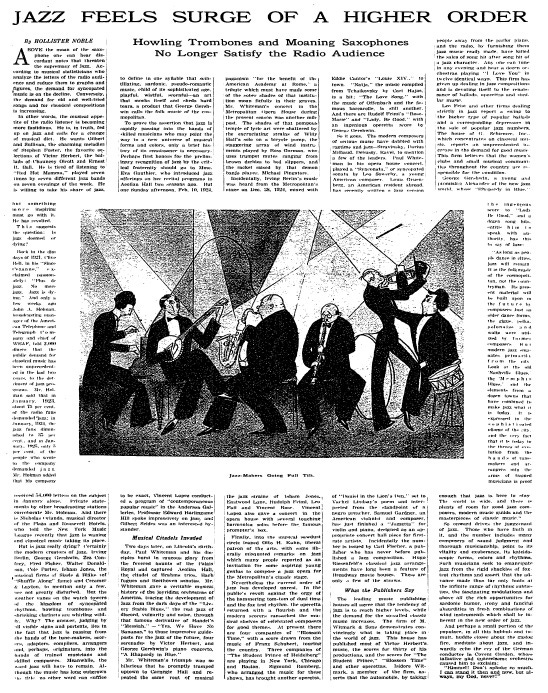Jazz Feels Surge of a Higher Order
"Is jazz doomed or dying?" a 1925 New York Times Magazine article asked. The answer: eventually yes, though it still reigned supreme for several decades more in the 1920s, 1930s, and 1940s.
The amazingly-named journalist Hollister Noble obviously didn't foresee the threat of rock 'n' roll in the 1950s, much less rap or hip-hop or R&B. Instead, he saw jazz's primary competitor as... a resurgence of classical?
The demand for syncopated music is on the decline. Conversely, the demand for old and well-tried songs and for classical compositions is increasing.
In other words, the musical appetite of the radio listener is becoming more fastidious. He is, in truth, fed up on jazz and calls for a change of musical diet.
He wants Gilbert and Sullivan, the charming melodies of Stephen Foster, the favorite selections of Victor Herbert, the ballads of Chauncey Olcott and Ernest R. Ball. He is tired of listening to "Red Hot Momma," played seven times by seven different jazz bands on seven evenings of the week.
Noble cited the head of programming at WEAF, at the time a New York City radio station:
Mr. Holman said that in January 1923, about 75 percent of the radio fans demanded jazz; in January 1924, the jazz fans diminished to 35 percent; and in January 1925, only 5 percent of the people who wrote to the company demanded jazz.
Clearly, the cultural supremacy of either jazz or classical didn't last. But even during my teenage and college years of the 2000s into early 2010s, jazz maintained some marginal foothold: think the Billboard chart success of Michael Bublé, Don't Know Why by Norah Jones, or Esperanza Spalding's 2011 Best New Artist Grammy Award. In the past dozen or so years, though, even that flicker of jazz as a cultural force seems to have shrunk to essentially zero.
Jazz Feels Surge of a Higher Order: Howling Trombones and Moaning Saxophones No Longer Satisfy the Radio Audience
Published: Sunday, March 15, 1925


